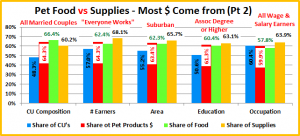2015 Pet Products Spending $44.4B – Part 3: Pet Food Compared to Pet Supplies
Pets, Food and Supplies account for 65.5% of Total Pet Spending and are often grouped as Pet Products. They do have many similarities in their spending demographics and they are certainly different from the Services group. However, there are also some distinct differences. We will take a closer look and compare the spending demographics of Food vs Supplies. Most of this final part of the report will be in the form of graphs which should make it easier to “see” the differences…and similarities. Plus, we will add some brief observations along the way. (Note: At the end of this post we will provide a link to download a full report on the Demographics of Pet Products Spending – a PDF file which combines all 3 parts into 1)
First, let’s put the 2 Industry Segments into perspective. Remember, overall Product Spending was $44.4B; Up $3.3B (+8.1%)
Pet Food (& Treats) – 2015 $29.5B; Up $5.4B (+22.5%);
- Share of Pet Products $ – 66.4%; Share of Total Pet $ – 43.5%
- This largest segment of the industry is truly “needed” spending for every Pet Parent. Of course, many treats are “discretionary” and you can exercise discretion in the price you pay. However, if you have a pet you must buy food.
Pet Supplies (& Pets) – 2015 $14.9B; Down $2.1B (-12.4%);
- Share of Products $ – 33.6%; Share of Total Pet $ – 22.0%
- This is the 3rd largest industry segment. While many Supplies are “needed”, many more are “discretionary. Also their “usage” rate is generally lower than Food items. A spending drop may just be the result of reduced purchase frequency.
Let’s first compare where most Food & Supplies Spending comes from…in the 2 charts that follow.
- In all but 2 of the categories, the same demographic group generates 60+% of the $ for both Supplies & Food.
- In the Age Group, Boomers, with their upgrade in Food are having a big impact. However, supplies perform better with all the younger groups and spending performance drops off markedly for age 55 and older.
- In the Occupation category, All Wage & Salary Earners doesn’t quite reach our 60% minimum for Food. This occurs because Retired people and No Earner CU’s have a large share of pets. Their spending on Food is necessary. Supplies is more discretionary. Income does matter but “how you make it”, not as much.
- Yes, Income does matter, especially to Supplies. Higher income is obviously important to both Food and Supplies. However, please note how the share of Supplies Spending increases both in the Income category and in those categories directly related to income, like # Earners, Education and Occupation. Income matters a lot to Supplies.
In the next 2 charts we’ll compare Food & Supplies in terms of the best and worst performing segments in 11 Demographic Categories. The similarities become immediately apparent. Although the performance may differ, the Best or Worst performing segment is the same for both Food & Supplies over 70% of the time.
- Income jumps right to the forefront again. It is important to both but more important to Supplies. Note the Over performance by Supplies in Income & Occupation “Best” and under performance in the “worst”. Note in Age “Best”: 45>54 is the highest income group.
- It is no surprise that Homeowners with a mortgage and rural/suburban areas are the best performers. Owning your own space and having a little more room to share with companion animals has always been a key to spending.
- Center City, Renters, Over 75, Singles and Single Parents are also traditionally low performing groups. However, we should note the improving performance, especially by Supplies in the Rental and Center City environments.
- You can see the impact of the Baby Boomer Food upgrade in the performances of 55>64 and Married Couples only.
- Most of these best and worst performers reflect the points already made. However, the performance of the Adv. Degree segment speaks for more than just income. It is also knowledge to see the true value in the Food Upgrade.
- The 2+ People winner for Supplies is interesting. After you reach 2 people in Supplies spending, all sizes of CU’s perform well and within 2 percentage points of one another. In Supplies Spending, it literally just takes 2.
Next, we’ll finally “show you the money.”
The Winners and Losers in Spending $ in 2015 – The Biggest $ changes
In the final section of this comparison, we will identify the segments that had the biggest gains and losses or smallest gains in spending $ for Pet Food and Pet Supplies. This is where specific differences come to the forefront. Only 30% of the winners or losers occupy the same “position” for both Food and Supplies. In fact, some are the winner in one and the loser in the other. For that reason, we will present Food and Supplies in separate charts. I have indicated the “dual” winners or losers by “boxing them in”. Take a look at both charts. Then we’ll wrap it up with some closing observations.
Overall, Food had a great year with a $5.3B increase and 6 categories with no negative segments. Supplies was the opposite story with a $2.1B decrease that seemed to affect everyone. I was surprised that I found 8 segments with positive numbers. Here are the impacting trends that we have seen reflected in this and earlier Demographic Analyses:
- The Baby Boomer Food upgrade – a huge impact. However, there were also increases in regular food spending.
- The <25 Millennials are becoming Pet Parents and even opting for upgraded food.
- The big drop in Food spending in the 25>34 group – probably a Food upgrade roll back due to financial pressures.
- The Overall drop in both Food and Supplies for the 25>44 age group. They are the traditional American H/H’s and affect a wide number of Demographic Categories. Like most drops, it was undoubtedly due to financial concern.
- Speaking of age, we also discovered that the younger groups are more “into” supplies than their older counterparts.
- We know that Income is an important factor in spending, especially for supplies, but “commitment” and education have also come to the forefront with the Food Spending Performance by Retired People and College Grads.
- All Racial/Ethnic groups bought more Food and Hispanics had an increase in both Food and Supplies spending.
- Renters and Center City both had increases in Food & Supplies. Pet Parenting is gaining in two normally slow areas.
We are truly “done”… for now. We have seen what happened in 2015. And as always, it raises big questions for the next year, like… Will the Boomers “stick with” their upgraded Food and will this trend become widespread across other demographics? Will the Supplies Segment rebound after a tough year? We’ll start to get answers in May with the release of the US BLS mid-year update.
Below is the link to download the complete 3 part report on the Demographics of Pet Products Spending.
(To save the PDF to your computer Right Click the download link and select “Save Link As…”)
[button link=”https://petbusinessprofessor.com/wp-content/uploads/2017/02/2015-PetProductsSpendingDemographics-FullReport.pdf” type=”icon” newwindow=”yes”] Download Full Report (PDF)[/button]









